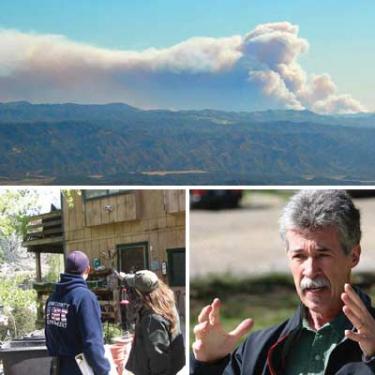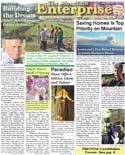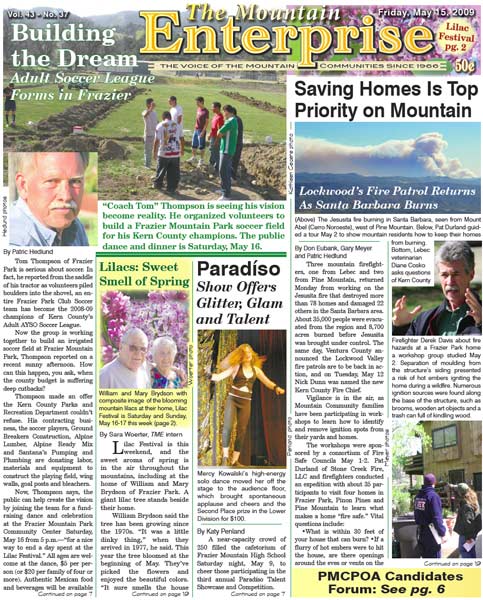
(Top) The Jesusita fire burning in Santa Barbara, seen from Mount Abel (Cerro Noroeste), west of Pine Mountain. Bottom left, Lebec veterinarian Diane Cosko asks questions of Kern County Firefighter Derek Davis about fire hazards at a Frazier Park home a workshop group studied May 2. Separation of moulding from the structure?s siding presented a risk of hot embers igniting the home during a wildfire. Numerous ignition sources were found along the base of the structure, such as brooms, wooden art objects and a trash can full of kindling wood. Bottom right, Pat Durland guided a tour May 2 to show mountain residents how to keep their homes from burning.
Lockwood’s Fire Patrol Returns As Santa Barbara Burns
By Don Eubank, Gary Meyer and Patric Hedlund
Three mountain firefighters, one from Lebec and two from Pine Mountain, returned Monday from working on the Jesusita fire that destroyed more than 78 homes and damaged 22 others in the Santa Barbara area. About 35,000 people were evacuated from the region and 8,700 acres burned before Jesusita was brought under control. The same day, Ventura County announced the Lockwood Valley fire patrols are to be back in action, and on Tuesday, May 12 Nick Dunn was named the new Kern County Fire Chief.
Vigilance is in the air, as Mountain Community families have been participating in workshops to learn how to identify and remove ignition spots from their yards and homes.
The workshops were sponsored by a consortium of Fire Safe Councils May 1-2. Pat Durland of Stone Creek Fire, LLC and firefighters conducted an expedition with about 35 participants to visit four homes in Frazier Park, Pinon Pines and Pine Mountain to learn what makes a home “fire safe.” Vital questions include:
- What is within 30 feet of your house that can burn?
- If a flurry of hot embers were to hit the house, are there openings around the eves or vents on the roof that could ignite? They need to be screened.
- What about the opening for your clothes dryer? Make sure yours is equipped with a special flap that will prevent embers from entering.
- How about your windows, are they open or closed during the fire danger time and do you have good screens attached and are they the fire resistant type? The fiber plastic type are not recommended.
- Are your rain gutters clean? Or are dried leaves stacked up in some areas or even piled into corners on the roof, such as around the chimney?
- Is there dead brush and tree limbs piled up and ready to burn?
While cleaning up your place, look for items that could be injurious to firefighters working in emergency conditions to protect the area.
The tour visited Oakmont Trail, up a steep and narrow dirt road. The trees are very thick, brush was everywhere. Open firewood lay uncovered. We were reminded of the “30 foot clear rule” around buildings or homes.
June 9 is the date by which brush needs to be cleared in this area. If you don’t clean your property the county may do it for you and send you a bill. You probably don’t want that to happen.
One way to get a lot of this brush and dead wood out of the way is to start a neighborhood clean up day. The Fire Safe Council has provided Chipper Days in most areas of the mountain in the past. Neighbors can share chain saws, clippers, or even rent a shredder. Make it a community project, neighbors helping neighbor. Once it’s started it will work.
Other local fire-abatement efforts include a dip tank being installed by the Pinon Pines water company. This tank will be for helicopters to load up on water to drop on fire hot spots. The tank will hold 3,600 gallons of water. It will be ready in June.
Firefighters are successful about 98 percent of the time. Don’t be caught with that other two percent, workshop participants were told, clear your property.
This is part of the May 15, 2009 online edition of The Mountain Enterprise.
Have an opinion on this matter? We'd like to hear from you.


